Core exercises dramatically enhance your trampoline workouts by stabilizing your body during bounces, enabling better mid-air control, and improving landing precision. Your engaged core acts as a command center, distributing force evenly throughout your body while strengthening abdominal, lower back, and pelvic muscles. You’ll notice improved balance, coordination, and posture with each session. The combination builds functional strength that translates to everyday movements and athletic performance. Discover how this powerful connection transforms your rebounding experience.
The Dynamic Core-Trampoline Connection
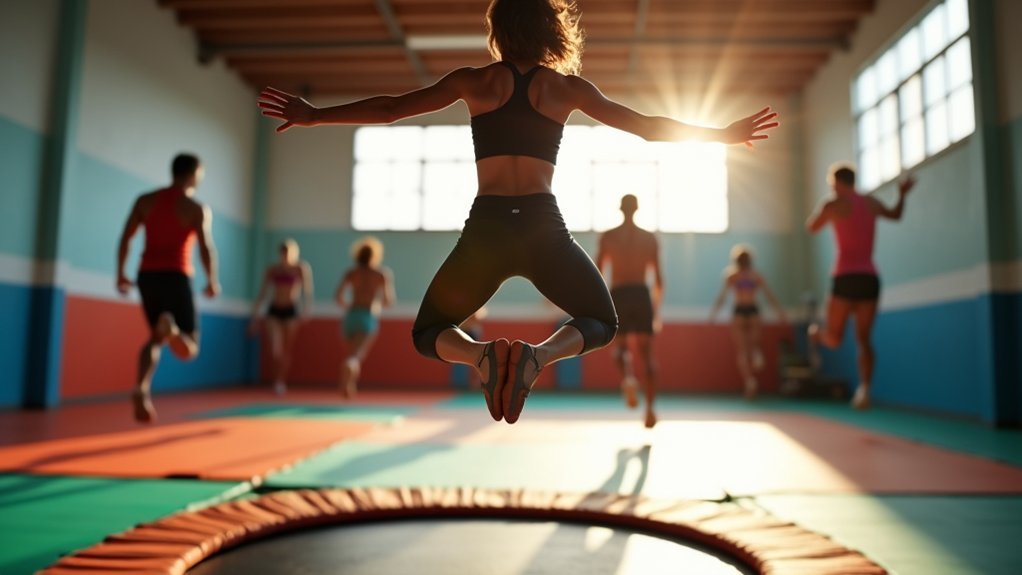
While many people jump on trampolines for fun, they’re actually engaging in a powerful core workout without even realizing it. Every bounce activates your abdominal, lower back, and pelvic muscles as they work to maintain balance and stability.
Your core serves as the command center during trampoline exercises, improving your posture while generating power for more effective jumps. This dynamic relationship works both ways—a stronger core enhances your trampoline performance, while consistent trampoline use strengthens your core muscles.
Think of your core as the trampoline’s partner—they strengthen each other in a continuous cycle of improvement.
The synergy creates a full-body workout that’s surprisingly low-impact. As you bounce, your core continuously engages to coordinate movement, absorb impact, and maintain proper alignment. Research has shown that this type of exercise can help increase bone density in the hip and spine, which is particularly important for aging populations.
This natural engagement makes trampolining an efficient way to develop core strength while having fun.
Mastering Stability in Mid-Air Movements
Your mid-air stability relies on core strength that enables precise balance during aerial twists and controlled rotations.
You’ll need to practice specific techniques that coordinate your core engagement with your body’s position as you spin or flip through the air.
Incorporating multiple muscle groups into your trampoline workout enhances your overall body control and movement precision while airborne.
When you master this core-centered control, your rebound landings will become more precise, allowing you to smoothly shift into your next trampoline movement.
Balance During Aerial Twists
Mastering aerial twists demands exceptional core control that goes far beyond basic trampoline skills. Your transverse abdominis and obliques work together to prevent over-rotation and maintain directional precision during mid-air movements.
When you twist, your body experiences asymmetric loading and centripetal forces that require constant abdominal tension to maintain your rotational axis. Without proper core engagement, you’ll likely compensate with arm flailing and lose control. Performing twists while bouncing helps engage obliques and core muscles effectively for better coordination.
Your internal obliques specifically help decelerate twist speed before landing, while your lower back muscles counterbalance rotational forces to protect your spine.
As you progress from 180° to 360° twists, you’ll need to develop anticipatory core engagement before liftoff.
Remember that controlled exhalation mid-twist optimizes your core bracing, giving you both stability and control throughout the movement.
Controlling Mid-Jump Rotations
Once you become airborne on a trampoline, controlling mid-jump rotations depends almost entirely on core activation patterns established before takeoff. Your transverse abdominis and obliques create the tension necessary to stabilize your torso during spins, preventing off-axis rotations during 180° or 360° maneuvers.
With a strong core, you’ll experience enhanced proprioceptive awareness, allowing you to make micro-corrections to body angles before landing. This improved spatial awareness reduces disorientation even during complex sequences. Maintaining proper arm position during turns provides additional momentum and control, as recommended in basic trampoline practice.
Your core muscles also regulate rotational speed through controlled contractions, preventing over-rotation and enabling clean shifts between directions.
When your core maintains proper postural integrity, you’ll preserve the kinetic chain alignment from feet to head, effectively managing rotational momentum through isometric holds and intentional energy redirection throughout your jumps.
Rebound Landing Precision
Although many focus solely on the height of their jumps, precise landings form the foundation of effective trampoline workouts. Your core muscles act as stabilizers, allowing you to maintain control throughout each bounce and land with precision.
To improve your landing precision:
- Strengthen your core and lower back muscles for better mid-air stability
- Practice proper alignment techniques that enhance your body’s symmetry during rebounds
- Utilize quality equipment with stable frames that support confident movements
- Develop consistent training routines that build muscle memory for controlled landings
You’ll notice improved coordination and balance as you master these techniques.
The stability gained from proper landing precision doesn’t just prevent injuries—it reveals your potential for more advanced moves and shifts while maximizing the cardiovascular and joint mobility benefits of rebounding. The Power Track’s exceptional frame design ensures you have the stability necessary for perfecting your landing technique during intense tumbling sessions.
Transforming Balance Through Proprioceptive Training
When you step onto a trampoline, your body immediately activates its proprioceptive system—the network of sensors that tell your brain where your body is in space. This dynamic environment challenges and enhances your balance in ways traditional workouts can’t match.
By incorporating exercises like one-leg balances and heel-to-toe movements on the trampoline, you’ll develop heightened body awareness and neuromuscular control. Your core muscles work overtime to maintain stability during these movements, creating a foundation for improved athletic performance and agility. Maintaining strong proprioception allows you to perform complex movements without conscious thought, making your trampoline workout more fluid and effective.
For seniors, this type of training offers particular benefits—reducing fall risk while building confidence in everyday movements. The trampoline’s unstable surface forces rapid proprioceptive adaptations, strengthening the mind-body connection and preventing muscle atrophy, all while making your workout more effective and enjoyable.
Optimizing Full-Body Muscle Recruitment

Your core acts as the command center for activating multiple muscle groups simultaneously during trampoline exercises, creating efficient synergy from your legs to your shoulders.
Through regular trampoline training, you’ll develop interconnected movement patterns that transfer seamlessly to athletic activities like jumping, twisting, and stabilizing.
Proper core engagement guarantees balanced distribution of forces throughout your body, preventing any single muscle group from becoming overloaded while maximizing power output during each bounce. The elastic nature of trampolines provides exceptional rebounding effects that amplify core muscle activation beyond traditional floor exercises.
Synergy Between Muscle Groups
While many exercisers focus solely on isolated core movements, trampoline workouts naturally create powerful muscle synergies that optimize full-body recruitment.
When you’re bouncing, your body constantly recruits multiple muscle groups simultaneously, creating integrated strength patterns you can’t replicate on stable surfaces.
- Your core activates to stabilize your spine while glutes generate explosive power, creating a kinetic chain that maximizes jump height.
- Obliques work with hip flexors to control rotational forces, preventing hyperextension during high-velocity rebounds.
- Lower body muscles function antagonistically, distributing impact forces across joints rather than isolating stress points.
- Upper body stabilizers counterbalance movement, maintaining your center of gravity while your arms assist in momentum transfer.
This muscular symphony reduces injury risk while amplifying workout efficiency. The consistent bouncing motion on a mini trampoline engages your deep core muscles which can provide significant support for pelvic floor health.
Unlocking Athletic Movement Patterns
The natural synergies developed on a trampoline directly translate to releasing athletic movement patterns found in competitive sports. When you engage your core during trampoline exercises, you’re optimizing muscle recruitment across your entire body.
Your core serves as the command center, integrating multiple muscle groups to perform complex movements with fluidity and precision. With each jump, your lower body muscles work synergistically with your abdominals, while your core simultaneously stabilizes your upper body. As you become more comfortable with trampoline bungees, you’ll notice significant improvements in your overall stability and balance control.
Dynamic movements like twist jumps and side steps enhance your coordination and agility—essential components of athletic performance. These exercises boost power output and speed while improving flexibility and range of motion.
Best of all, you’re conditioning these athletic patterns through low-impact training that doesn’t stress your joints.
Balanced Load Distribution
Unlike traditional workouts that isolate muscle groups, trampoline training distributes workload evenly across your entire muscular system. When you bounce, your body naturally engages in cross-muscle synergy, creating a harmonious balance between opposing muscle groups.
- Your core muscles co-contract during rebounds, enhancing force absorption while maintaining spinal alignment.
- Arm movements counterbalance leg actions, recruiting shoulder stabilizers while your trunk rotates to control direction.
- Each bounce synchronizes your diaphragm with pelvic floor activation in a rhythmic pattern.
- The elastic surface reduces joint stress while challenging your body’s proprioceptive systems through constant micro-adjustments.
Incorporating movements like gentle side-to-side rocking with soft knees helps establish proper form and engages the core from the beginning of your workout. This balanced approach means you’re not just working your legs or arms independently—you’re training integrated movement patterns that translate to improved coordination in everyday activities.
The Neuromuscular Benefits of Core-Focused Rebounding
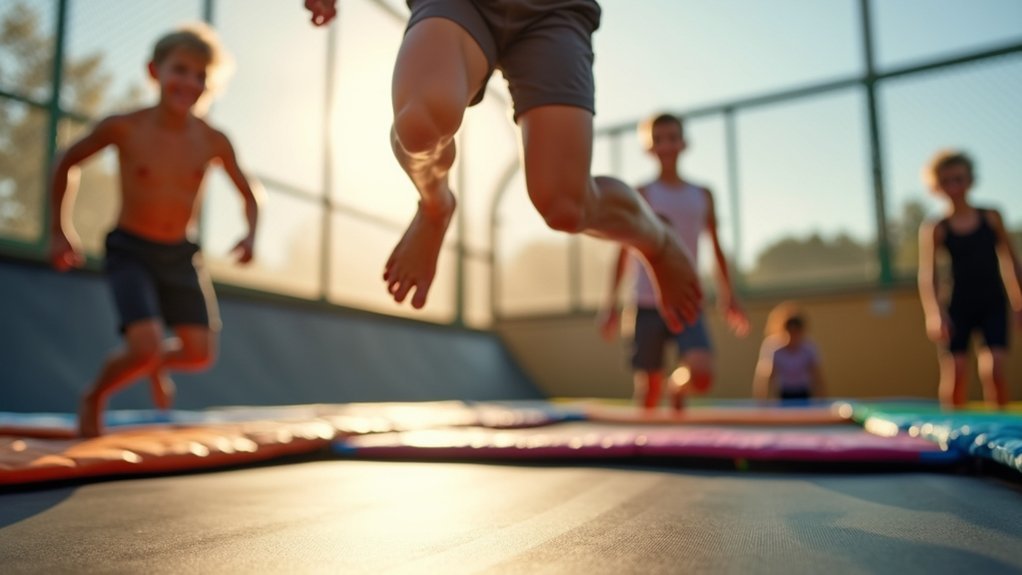
Jumping on a rebounder doesn’t just give you a cardiovascular workout—it creates a powerful connection between your brain and muscles. This neuromuscular training improves your motor skills and balance by challenging your body to stabilize on an unpredictable surface.
Your core muscles play an essential role in this process. As you bounce, they constantly engage to maintain stability, enhancing the efficiency of movement between your limbs and torso. This improved core strength directly reduces your risk of dynamic joint instabilities during everyday activities.
Core engagement during rebounding creates a stable foundation, optimizing movement efficiency and protecting your joints in daily life.
The constant adjustments required during rebounding boost your proprioception—your body’s awareness of its position in space. Regular rebounding also helps stimulate the lymphatic system for improved toxin removal from the body.
You’ll notice enhanced coordination as your neuromuscular system adapts to these challenges, ultimately supporting better athletic performance and reducing energy leaks in all your movements.
Protecting Joints While Maximizing Core Engagement
While many high-intensity workouts can strain your joints, rebounding offers a unique balance of challenge and protection. The trampoline’s soft, cushioned surface absorbs impact that would typically stress your knees, ankles, and hips during conventional exercises, while still fully engaging your core muscles. This approach reduces force on joints by approximately 80 percent compared to exercises like running on pavement.
- Maintain proper alignment during jumps to maximize core activation
- Incorporate directional changes and rotational movements to target deep stabilizing muscles
- Start with basic bounces before progressing to more complex moves
- Focus on controlled, deliberate movements rather than height
Building Bone Health Through Strategic Core Activation
Your core muscles play a critical role in supporting proper bone loading during trampoline exercises, creating the ideal conditions for bone strengthening.
Maintaining correct posture through the absorption and distribution of force requires active engagement of your abdominal, back, and pelvic muscles.
The milkmaid arm movement introduced during rebounding specifically targets core control while simultaneously improving upper body coordination and stability.
You’ll maximize bone health benefits by focusing on strategic core activation during each bounce, allowing controlled compression that stimulates bone density development without excessive impact.
Core-Supported Bone Loading
Three key mechanisms make trampoline workouts exceptional for bone health when you properly engage your core. Your stabilized core distributes impact forces evenly across your skeletal structure, creating the perfect environment for adaptive bone remodeling.
When you activate your core during rebounds, you’re stimulating osteoblast activity through intermittent compression forces.
- Core-controlled landings optimize impact forces, maintaining osteogenic thresholds while reducing harmful peaks.
- Multi-directional balance challenges engage deep spinal stabilizers that directly influence vertebral loading patterns.
- Coordinated abdominal-pelvic activation creates compressive loads beneficial for spinal bone density.
- Core-generated mechanical loading triggers bone-building hormone release (IGF-1, growth hormone).
Your strengthened core allows for progressive intensity increases, enabling gradual bone adaptation through varied loading patterns.
This core-mediated bone stimulation provides superior benefits compared to static exercises.
Posture Through Force
Proper posture emerges naturally when you strategically activate your core muscles during trampoline exercises, creating ideal force distribution for bone strengthening.
As you jump, your core stabilizes your spine, optimizing biomechanical efficiency while protecting vulnerable joints. This core engagement guarantees forces travel correctly through your skeletal system, stimulating bone density improvements without excessive strain on any single area.
You’ll notice your balance improving as your neuromuscular coordination develops, allowing for more controlled landings and takeoffs.
The multidirectional movements on a trampoline challenge your core from various angles, enhancing kinesthetic awareness and postural control.
Postural Improvements From Rebounding Core Work
While traditional core exercises build strength, rebounding on a trampoline elevates postural training to new heights.
The unstable surface challenges your stabilizing muscles to maintain balance, naturally correcting alignment issues as your body responds to the changing surface.
Research with stroke patients confirms that just three weeks of mini-trampoline training notably improves postural control.
The neuromuscular training you receive during exercises like air bike, jump and tuck, and twisting jumps delivers thorough benefits:
- Engages deep core muscles that support proper spinal alignment
- Develops coordination that translates to better everyday movement patterns
- Strengthens stabilizing muscles without stressing joints
- Improves balance through constant micro-adjustments during rebounding
You’ll find your posture improving as core muscles learn to maintain proper alignment during both exercise and daily activities. Remember to maintain a micro bend in knees while rebounding to prevent hyperextension and optimize core engagement.
Cardiovascular Efficiency Through Core Stabilization
Strong core muscles fundamentally transform your cardiovascular efficiency during trampoline workouts by creating a stable foundation for your entire body.
When you engage your core while rebounding, you’re simultaneously increasing your heart rate and enhancing oxygen circulation as multiple muscle groups work together.
This synergistic effect boosts your cardiovascular system’s performance without the joint stress typically associated with high-intensity training.
Your strengthened core supports proper form during dynamic movements, reducing fatigue and allowing you to maintain higher intensity levels for longer periods.
The result? You’ll develop greater stamina as your heart functions more efficiently during exercise. This improvement in efficiency is especially beneficial for children who need regular exercise to develop strong heart muscles as they grow.
Advanced Core Techniques for Rebounding Progression
Mastering advanced core techniques on a trampoline requires progressing beyond basic bouncing to incorporate dynamic movements that challenge your stability.
As you become comfortable with fundamental exercises, you’ll want to intensify your routine by adding rotational elements and resistance training.
- Try air bike crunches by lifting your shoulders and bringing opposite knees to elbows while maintaining balance on the rebounding surface.
- Incorporate jump and tuck movements (knees to chest) to specifically target abdominal muscles.
- Add HIIT-style interval training with alternating high and low-intensity core exercises.
- Challenge yourself with single-leg balance exercises that force your core to stabilize during asymmetrical movements.
Remember to maintain proper form throughout these advanced techniques.
Consistency is key—regular practice of these progressive movements will greatly improve your core strength and overall rebounding performance. Following a block-based structure similar to Michelle Briehler’s workout can help you organize your core exercises effectively for better results.
Functional Fitness Benefits Beyond the Trampoline
The benefits of trampoline core workouts extend far beyond the bouncing surface itself, transforming your everyday movements and activities.
You’ll notice improved balance and coordination in daily tasks, greatly reducing your risk of falls and injuries.
Regular rebounding strengthens your pelvic floor muscles, providing essential stability for your core structure. This translates to better posture and movement efficiency throughout your day.
Your immune system may also get a boost as the up-and-down motion stimulates lymphatic circulation, helping flush toxins from your body.
Perhaps most surprisingly, you’ll experience enhanced mental clarity and improved mood – benefits that impact everything from work performance to personal relationships. With just 45 minutes of rebounding, you can achieve a comprehensive fitness boost that fits easily into even the busiest schedules.
The motor skills you develop on the trampoline transfer to improved muscle tone and movement precision in all physical activities.
Injury Prevention Through Core-Centric Rebounding
While enjoying the dynamic nature of trampoline workouts, you’ll find that injury prevention hinges on developing core strength and stability. Your activated core muscles absorb landing shock and maintain proper spinal alignment during repetitive bouncing, markedly reducing strain on your ankles and knees.
- Core stabilization distributes impact forces across your abdominal wall and back muscles, preventing compensatory movements that overload secondary muscle groups.
- Strong core endurance prevents form breakdown during lengthy sessions, maintaining proper knee tracking and limiting excessive shoulder tension.
- Core contractions counteract surface instability through micro-adjustments during the aerial phase of jumps.
- Enhanced proprioception strengthens neuromuscular communication for precise landings, reducing your risk of awkward torsional movements and falls.
Performance Enhancement for Athletes Using Core Rebounding
Beyond injury prevention, your core-focused trampoline routine offers substantial performance benefits for athletes across various sports disciplines.
By stabilizing your torso during rebounds, you’ll transfer force more efficiently from lower to upper body, amplifying your vertical jump and directional control.
Core stability during rebounding creates a power pipeline that transforms lower body force into explosive height and precision movement.
Your body learns to make constant micro-adjustments that improve proprioception and develop essential neural pathways for whole-body coordination. This strengthens the deep abdominal muscles responsible for explosive movements while enhancing rotational power for quick directional changes.
You’ll experience improved cardiovascular efficiency as core stabilization reduces energy leakage during sustained rebounding.
The training mimics sport-specific movements—from basketball leaps to swimming starts—while the low-impact nature accelerates recovery through enhanced lymphatic circulation and reduced muscle soreness.
Frequently Asked Questions
How Long Should Core Exercises Be Incorporated Into Trampoline Routines?
Incorporate 30-60 second core bursts between trampoline sets and dedicate 10-15 minutes weekly to core-specific exercises. You’ll benefit from 2-3 minute post-warmup core work to prepare your stabilizing muscles for dynamic movements.
Can Children Benefit From Core-Focused Trampoline Workouts?
Your children will definitely benefit from core-focused trampoline workouts. They’ll improve their balance, coordination, and motor skills while having fun. These workouts also enhance their concentration and proprioception naturally.
Is a Mini-Trampoline as Effective as a Full-Sized One?
Mini-trampolines can be as effective as full-sized ones for exercise, but they’re different tools. You’ll get good cardio benefits from both, though full-sized trampolines offer more space for varied movements.
How Do Core-Trampoline Workouts Affect Those With Back Pain?
Core-trampoline workouts can help you manage back pain through low-impact movements that strengthen core muscles. You’ll improve stability, posture, and flexibility while reducing joint stress, but you should always consult your healthcare provider first.
What Clothing Is Most Appropriate for Core-Focused Rebounding Exercises?
For core-focused rebounding, you’ll want moisture-wicking, form-fitting attire with four-way stretch fabric. Choose high-waisted compression leggings, supportive sports bras, and non-slip grip socks to maximize stability during dynamic movements.
In Summary
By incorporating targeted core work into your trampoline sessions, you’ve discovered the secret to revealing remarkable fitness gains. You’re not just bouncing—you’re building functional strength that transfers to daily activities and sports performance. Your improved stability, balance, and muscle coordination won’t just elevate your rebounding experience; they’ll transform your overall athletic capacity while protecting your body from injury. Keep engaging that core!

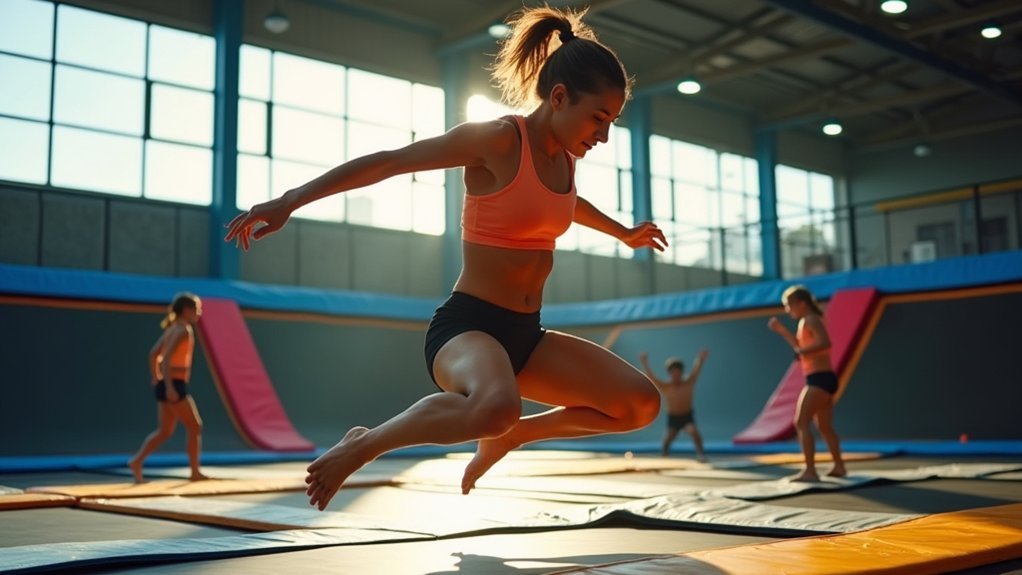
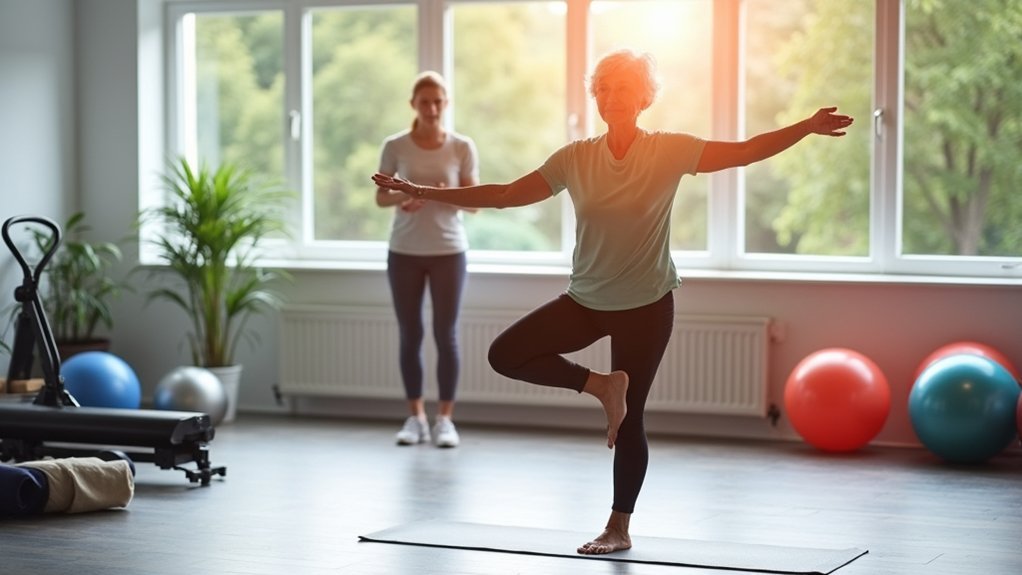
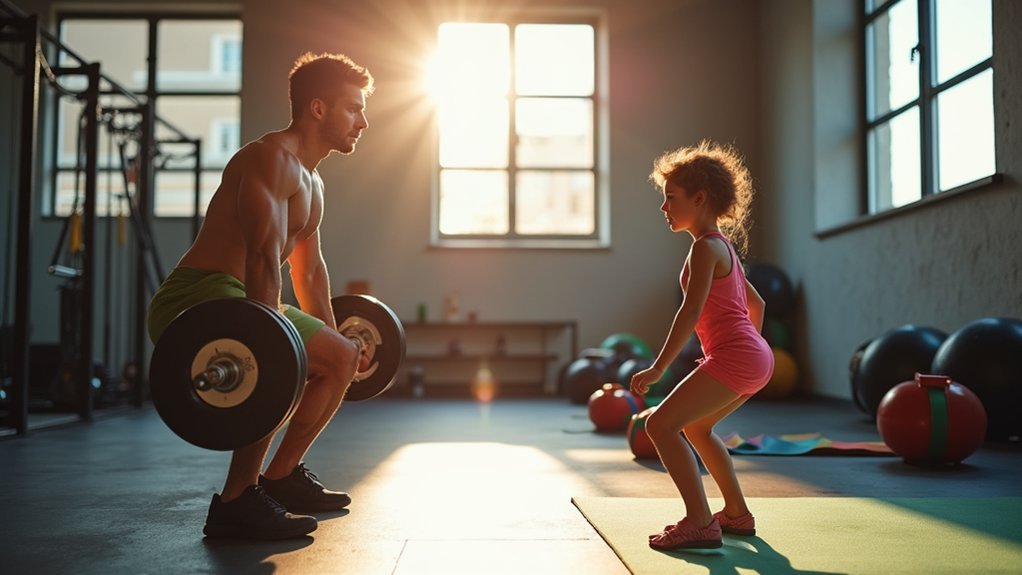

Leave a Reply